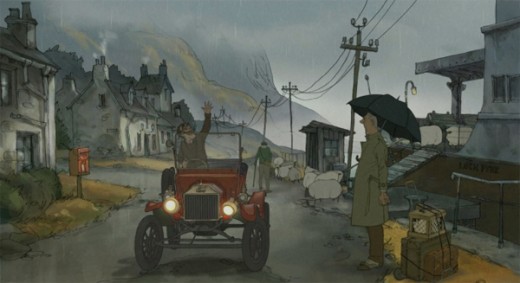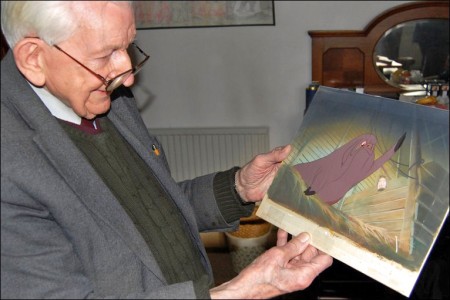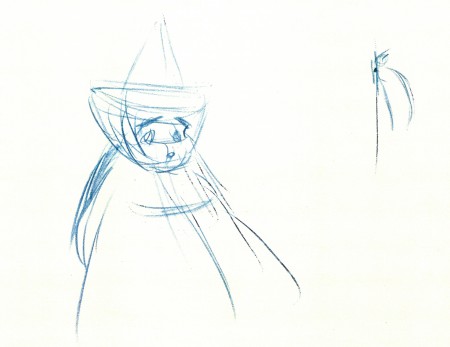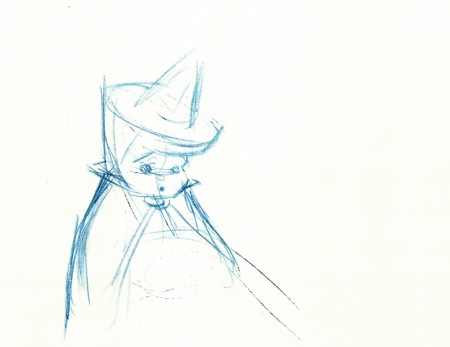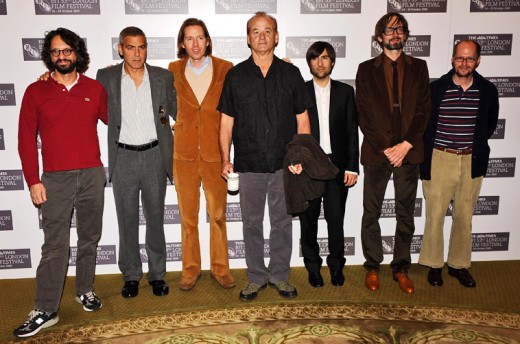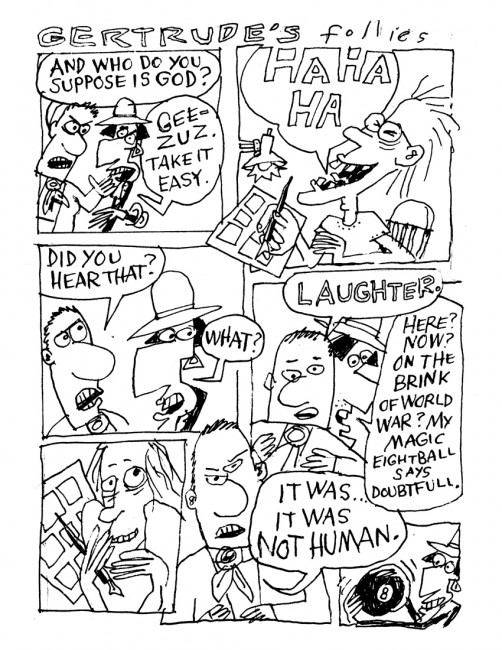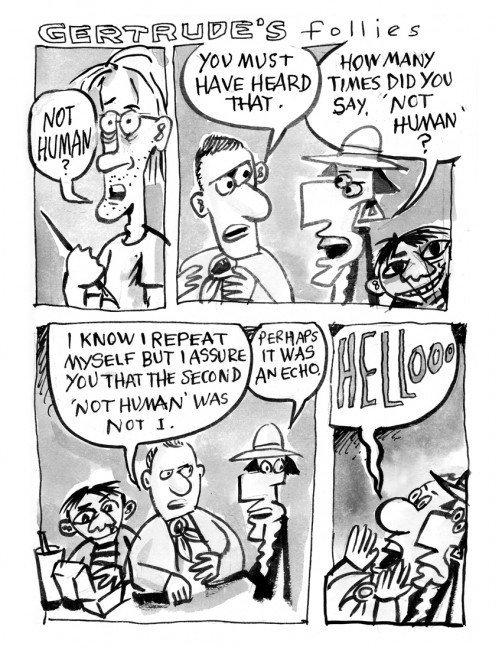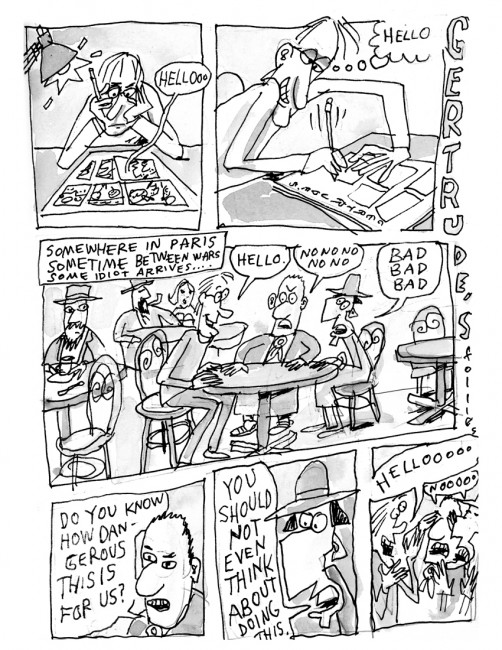Search ResultsFor "sleeping beauty"
Animation &Articles on Animation &Commentary 06 May 2010 07:21 am
Dragons & Fanny
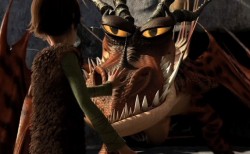 - For the past few weeks, Michael Barrier’s review of How to Train Your Dragon has been on my mind. Actually, not most of the review, just the last two paragraphs. Most of the review talks about the Dreamworks film, and, I must say, it doesn’t encourage me to see it (which I eventually will most certainly do – once they screen it in 2D in New York).
- For the past few weeks, Michael Barrier’s review of How to Train Your Dragon has been on my mind. Actually, not most of the review, just the last two paragraphs. Most of the review talks about the Dreamworks film, and, I must say, it doesn’t encourage me to see it (which I eventually will most certainly do – once they screen it in 2D in New York).
I haven’t yet seen it , but the film, from the ads I’ve seen, looks like the generic Dreamworks product. All of the characters are supposed to be Vikings living in the First Century, but they act and sound like generic animated characters in the 21st Century. It’s just about a given for such current product. The stock facial expressions, the overarching eyebrows, the attitude. In all of the ads and clips I’ve seen, America Ferrara screams every one of her lines. That’s what poses for acting today in most animated films – a direct influence of TV.
Perhaps I’m wrong, but I somehow doubt it. I’ll find out for myself when I do see it. (After all I put down Kung Fu Panda, and I now think pretty highly of that film.) Regardless, this isn’t the part of the commentary that Mike’s written that has my thoughts rambling about.
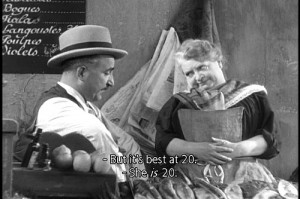 He jumps in his review to Marcel Pagnol’s Fanny Trilogy. Seeing these three films is perhaps one of my all time favorite movie experiences. They played in NY in the 70’s on three consecutive Mondays. I got so hooked into it, I looked forward enormously to those Monday showings. Mike describes them beautifully. All character development and a simple straightforward story that just about breaks your heart. It’s a wonderful film experience despite the fact that it’s a crusty old 1930’s film with lots of soft grays and soft focus. They’re obviously sets built around the Marseilles they’re pretending to create, but you buy it all. At least I did; it’s so wonderfully Romantic.
He jumps in his review to Marcel Pagnol’s Fanny Trilogy. Seeing these three films is perhaps one of my all time favorite movie experiences. They played in NY in the 70’s on three consecutive Mondays. I got so hooked into it, I looked forward enormously to those Monday showings. Mike describes them beautifully. All character development and a simple straightforward story that just about breaks your heart. It’s a wonderful film experience despite the fact that it’s a crusty old 1930’s film with lots of soft grays and soft focus. They’re obviously sets built around the Marseilles they’re pretending to create, but you buy it all. At least I did; it’s so wonderfully Romantic.
(Perhaps, that’s a generational thing. I talked an intern in my studio into watching Citizen Kane, and she couldn’t get through it. The B&W was too distracting for her, and she found the film boring. What can you say?)
Mike Barrier rightfully makes the leap to Snow White and the Seven Dwarfs, a natural link – animation wise – to Pagnol’s trilogy. The approach is very similar. Somehow I’d never have seen the link to these films, but it works. Despite the enormous difference in story, the dependence on character development and motivation are alike. A sweet, simple, direct story with very strong character personality holds you tightly throughout.
A lot of this approach stayed with the Disney features right through Sleeping Beauty. I love the first 10 or 15 minutes of all those films; nothing but character setup, and they’re all wonderful. Things started to change with 101 Dalmatians and had been just about abandoned by the time they got to The Aristocats. Character suddenly became reliant on celebrity voices. Thanks to the star turns such as Phil Harris’ Baloo the Bear in Jungle Book, it became easier for animators to pull their characters together. Let the voices do the heavywork, and in The Aristocrats, they ran with it to the film’s detriment.
Now we get unidentifiable celebrities, like America Ferrara, shouting their lines but adding nothing to the character’s personality. I’m not even sure if her name will help sell a DVD. Given these flat voices, the animators turn to their stock poses and facial expressions, and the end result is a sad lot.
I’d like to think that Chris Sanders and Dean DeBlois have surpassed the Dreamworks formula and taken their film to another level. I have been a big fan of Lilo and Stitch, although I think much of the story is hackneyed nonsense. (Whenever we have to see aliens fighting from their spaceship, it’s hard to reconcile that with the wonderful character traits between Lilo and Stitch, themselves.) The beautiful artwork choices help carry you through that film. Mike suggests that the end of Dragon may have as big a problem, and he offers to blame that on the executives above Sanders and DeBlois. Perhaps, but Lilo and Stitch had similar problems.
Mike Barrier suggests that that isn’t the entire case with How to Train Your Dragon, and I do hope he’s right. But nothing I’ve seen to date lets me expect it. I do want to be pleasantly surprised, and I’ll let you know if I am.
The film I’m really waiting to see is Sylvan Chomet’s The Illusionist. The story in Triplettes of Belleville fell apart, but the execution and development of the principal personalities was so fine, that the film offered me plenty – and plenty of hope. I do hope and almost expect to see that he has taken this approach to another level. What little I’ve seen leads me to believe I may not be disappointed.
Articles on Animation 27 Mar 2010 08:13 am
Harald Whitaker / Don Hahn
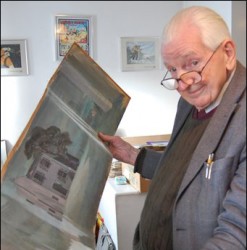 - I wasn’t aware that Harold Whitaker was still alive and kicking until I’d received this note from Animal Farm aficionado, Chris Rushworthy:
- I wasn’t aware that Harold Whitaker was still alive and kicking until I’d received this note from Animal Farm aficionado, Chris Rushworthy:
- I came across this BBC online article the other day. It has some very interesting images of Harold Whitaker and some of his Animal Farm collection. I salivated over the original background shown for the Old Major speech scene of which I have most cels and camera sheets.
Go here to see the pictoral piece.
Whittaker, of course, was the leading animator at the Halas & Batchelor studio for many years. After retiring from H&B, he wrote the book on Animation Timing that, to me, is one of the finest books available on animation production. The book, Timing for Animation, was recently updated by Tom Sito and is widely available. Everything in the book is explained in a deceptively simple way, yet it beams with clarity few other animation books achieve. I haven’t seen the updated version of the book, though I’m sure it stays true to Whitaker’s original.
Many thanks to Chris for directing me to this piece from the BBC; the photos are first rate.
Go here to visit Chris Rushworthy’s excellent site built around his collection of Animal Farm artwork.
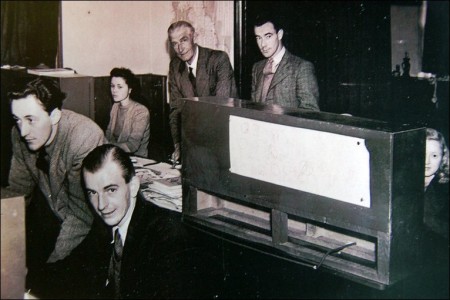
Whittaker (front center) at the Anson Dyer studio.
____________________
– With the opening yesterday of Waking Sleeping Beauty, there’s a timed interview with Don Hahn in the Onion’s AVClub. It’s a long and excellent read with some pointed questions asked and answered. Here, for example, is one that caught my eye:
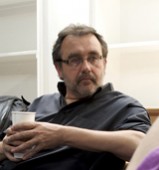 AVC: The story the film is telling changes throughout the film. It starts out being about the animators, and it ends up being about the executives. Did you always start out with that arc? Did it change as you got access to some of these people?
AVC: The story the film is telling changes throughout the film. It starts out being about the animators, and it ends up being about the executives. Did you always start out with that arc? Did it change as you got access to some of these people?
DH: We had access from the beginning. Some of the earliest talks we did were with some of the executives. I think what we wanted to do though, was—I didn’t want to create class distinctions between executives and artists. I didn’t want to create a good-guy/bad-guy scenario from the very beginning. I think that’s a little simplistic. The truth is, without the executive boldness and the artistic achievement, it wouldn’t have happened. I don’t think we even use the word “executive†in the movie. We talk about these people. We talk about who they are and what they do, but it was important to show that everybody had a role at the table, and if you pulled one of those people out, the checks and balances would be thrown off a little bit.
So the arc of the story was somewhat determined by what literally happened. It was a group of lost boys, a group of people right out of school with big dreams that couldn’t be expressed yet. And then having Wells and Eisner and Katzenberg come into the studio—at the same time Howard Ashman comes in—and you have this tremendous renaissance, a change in the approach, outsiders coming in, Roger Rabbit happening, and this huge growth in the potential of animation that culminates in great financial success, that culminates in some egos getting in the way. Then Frank Wells’ death is the domino that pushes over and starts to unravel a lot of those situations, which culminates in the end of the movie.
The film is a must-see for anyone connected with animation who takes Disney films seriously. It’s a strong entertainment and a producer’s vision of what he saw while living through it. Currently it’s at the Landmark Sunshine Theater in New York.
____________________
Commentary &Disney 18 Mar 2010 08:39 am
Waking Sleeping Beauty
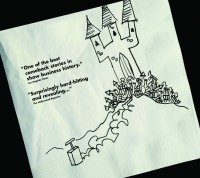 - Waking Sleeping Beauty is a tightly edited documentary detailing the years between 1984 and 1994 at the Disney Animation Studio. From The Black Cauldron through The Lion King. There’s ample footage of the artists in meetings – particularly story meetings, goofing around and walking the halls of the old Animation building on the Disney lot.
- Waking Sleeping Beauty is a tightly edited documentary detailing the years between 1984 and 1994 at the Disney Animation Studio. From The Black Cauldron through The Lion King. There’s ample footage of the artists in meetings – particularly story meetings, goofing around and walking the halls of the old Animation building on the Disney lot.
Yet the story being told – without an iota of fat – is the story of the above-the-line players and how they felt about each other. The machinations and power plays they work on each other to wrest control and credit for the studio’s success is the primary interest of this film, not the attitudes and thoughts of the animation people.
Only a couple of times do we really get to imagine how the artists felt about what was going on. There’s a meeting called by Katzenberg to talk about how the people felt about the period. They explained that they weren’t able to spend appropriate time with their families because of all the excess overtime that was demanded of them. Katzenberg tears up and promises that things will get better. They don’t; things get worse.
Throughout the film is colored with home movie footage taken by Randy Cartwright of a lot of the animators and artists mugging for the camera. The only shot that gives an inkling that something serious is going on is a shot where Tim Burton is caught at his drawing board, and he literally doesn’t know what to do. Frustration, irritation and annoyance beams off his face. It was one of the biggest laughs for the audience surrounding me. There are ample and tight closeups of many of these people: Tom Sito, Andreas Deja, Eric Goldberg, Joe Ranft, Roger Allers, Mike Gabriel and many more. Yet, none of them – NONE – are labelled and identified.
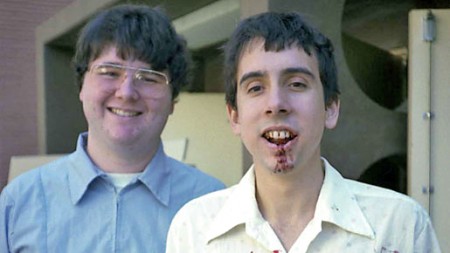
Joe Ranft and Tim Burton still don’t recieve identification in this film.
Yet their images are known by many outside the industry.
Yet, every executive gets clear identification. Even the full list of end credits runs alongside running footage of people/artists in the studio saying hello and playing for the camera. Yet, none of these people are identified. I’m not even sure their names appeared in the credits since it was hard to watch the running type while trying to see the archival footage.
Despite this complaint, the story told was engrossing. Since I can identify most of the people, I was also absorbing every frame of the home movies and the footage shot for PR sake that also filled the film.
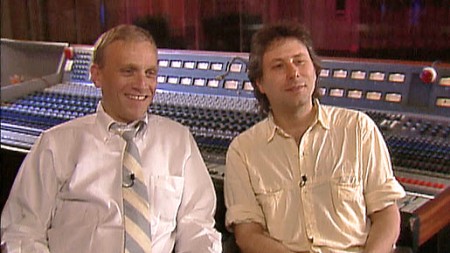
Howard Ashman and Alan Menken are given the due credit for both The Little Mermaid and Beauty and the Beast and, to some extent, Aladdin. Ashman, as we know, had a lot to do with the shaping of both films. I’d already given credit to him for much of the guidance of the two films, so it was good to see the filmmakers support this. In many ways, in my mind, a great deal of credit for this renaissance fell on his shoulders.
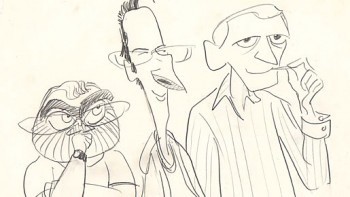 In fact, I’m surprised, given the enormous success the studio has had over the years with Alan Menken’s songs and music, that they didn’t bring him in for The Princess and the Frog. Menken brought good luck to so many of the animated features of this period that one wonders if it may have helped. Given his successful track record, there was more likelihood that he might have brought something to the film. They were trying to reboot their musical franchises, yet they turned to Randy Newman – who’d been hit and miss for them at Pixar. Perhaps the Pixar connection gave Newman the upper hand with John Lasseter, probably finalizing that decision.
In fact, I’m surprised, given the enormous success the studio has had over the years with Alan Menken’s songs and music, that they didn’t bring him in for The Princess and the Frog. Menken brought good luck to so many of the animated features of this period that one wonders if it may have helped. Given his successful track record, there was more likelihood that he might have brought something to the film. They were trying to reboot their musical franchises, yet they turned to Randy Newman – who’d been hit and miss for them at Pixar. Perhaps the Pixar connection gave Newman the upper hand with John Lasseter, probably finalizing that decision.
The film includes newly recorded interviews with many of the higher salaried artists which overlapped some of the footage and helped to move the story. Eisner, Katzenberg or Roy Disney are also seen in detailed comments taken from press releases, all of which underlines the lust for power over the animation studio. The fever pitched competition between Disney and Katzenberg is certainly highlighted.
Don Hahn directs the film with assuredness, and he acts as the primary narrator – though, producer, Peter Schneider‘s high-pitched comments certainly color the film as well.
It’s a tense and serious attempt to record a POV of one very successful period at the Disney studio, and to a great extent they get it. However, since it is made by two people in a position of power, their interest is definitely focussed on the four people above them – Eisner, Disney, Katzenberg and Wells. To be honest, I’m not sure the drama would have held if you’d concentrated on the people below their level. However, I do think the artists deserve at least to have been identified.
It’s a very entertaining film for those interested in animation and Disney, in particular.
The film opens in four cities on March 26th: NY, LA, SF and Chi. You can see it at the Landmark Sunshine theater in NY.
Commentary 16 Mar 2010 07:52 am
Haiti and other stuff
- I received the following film in an email from Karl Cohen in San Francisco. Karl writes: “Alan Sperling is a former employee of Richard Williams when he had a studio in LA and has worked in SF for many years.”
In fact Alan also animated on Cool World, Toy Story, and Monsters Inc.
He did the following film, Scratch, for the Haitian relief effort and he’s just trying to get it seen by as many people as possible. So take a look, if you haven’t seen it as yet.
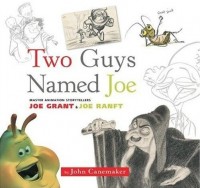 - Recent posts about the internet toast the 50th birthday of the late Joe Ranft.
- Recent posts about the internet toast the 50th birthday of the late Joe Ranft.
I think the most fitting tribute for this man will come later this year when John Canemaker‘s beautifully written and sensitive book, Two Guys Named Joe arrives in book stores. The stories of Joe Ranft and Joe Grant are detailed, elaborated and interrelated without an iota of sentimentality. This is a gorgeous and strong book and a magnificent tribute to both Ranft and Grant. It’s one of the best books in John’s canon. Look for it in August.
 Speaking of Joe Ranft, I saw a screening at MOMA last night of Waking Sleeping Beauty, a must for any animation enthusiast. It’s a fast paced intriguing story when all layed out. I’ll review the film later this week. I just wanted to mention that Joe Ranft was featured prominently (though never identified) throughout the film. He, obviously, was a big part of that period.
Speaking of Joe Ranft, I saw a screening at MOMA last night of Waking Sleeping Beauty, a must for any animation enthusiast. It’s a fast paced intriguing story when all layed out. I’ll review the film later this week. I just wanted to mention that Joe Ranft was featured prominently (though never identified) throughout the film. He, obviously, was a big part of that period.
I also got to meet Tomm Moore, who sat in front of me, at the screening. I’m pleased to finally be able to put a face to The Secret of the Kells. I’ve seen the film twice and have a lot of respect for the enormous production he was able to pull off so successfully. It’s so hopeful for all of us independents to see the little guy with so tiny a distributor making such large waves.
- Other sites talk about the press release this past week of Disney’s closing Imagemovers Digital, the company Robert Zemeckis used to make his last couple of MoCap features. This was hardly great news given the costs that those films absorbed. When the Jim Carrey Christmas Carol costs $174 million, it’s unlikely to return its investment. Ultimately, it will probably break even, but one wonders if the same financial “success” wouldn’t have been achieved using traditional animation. When Bolt costs $150 million and returns $114 from US receipts, it’s averaging about the same as the $50 million loss Christmas Carol currently shows. Beowulf had a $150 million budget and brought in $82 million.
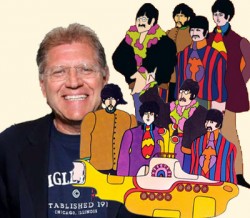 It seems clear to me that the writing was on the wall. The wonder is that Disney still has the deal to release The Yellow Submarine. Undoubtedly that film will ignore the great graphics of the original to bring us a MoCap version of the four Beatles – in that wonderful Zemeckis “walking-dead” style. How much can that lose – and cost?
It seems clear to me that the writing was on the wall. The wonder is that Disney still has the deal to release The Yellow Submarine. Undoubtedly that film will ignore the great graphics of the original to bring us a MoCap version of the four Beatles – in that wonderful Zemeckis “walking-dead” style. How much can that lose – and cost?
Remember, a bad movie is a bad movie, whether it’s traditionally animated like Treasure Planet or cgi like Space Chimps or MoCap like Beowulf. Disney’s not moving away from financing bad movies, they’re cutting costs on financial risks.
- For those of you not living in New York, this is the kind of outdoor advertising Adult Swim uses to promote its wares.
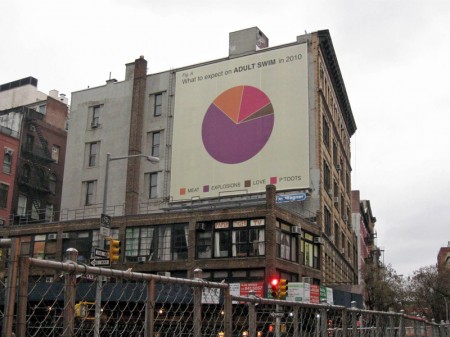
.
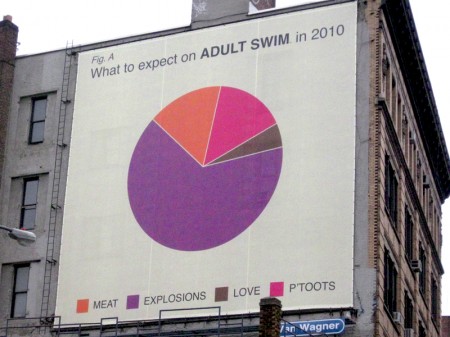
.
Almost as good as the shows themselves. 25% P’Toots.
________________
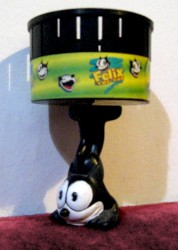 - Finally, I wanted to revisit something Amid Amidi posted on Cartoon Brew over the weekend. Brian Duffy wrote to me to introduce me to a couple of sites. As an enormous fan of optical toys, with a mini collection of non-authentic pieces of my own, I rushed to look at the wares on the site, the Richard Balzer collection. There, I loiotered for hours and have returned many times since first viewing them. Everyting from Praxinoscopes to Thaumatropes to Zoetropes are displayed in a stunning collection of artifacts in this wealthy collection. They also have a blog, dickbalzer.blogspot.com, which is demonstrating via flash videos how the pieces operate. I look forward to viewing some of the zoetrope animations and will continue to return for updated pieces. I love this stuff.
- Finally, I wanted to revisit something Amid Amidi posted on Cartoon Brew over the weekend. Brian Duffy wrote to me to introduce me to a couple of sites. As an enormous fan of optical toys, with a mini collection of non-authentic pieces of my own, I rushed to look at the wares on the site, the Richard Balzer collection. There, I loiotered for hours and have returned many times since first viewing them. Everyting from Praxinoscopes to Thaumatropes to Zoetropes are displayed in a stunning collection of artifacts in this wealthy collection. They also have a blog, dickbalzer.blogspot.com, which is demonstrating via flash videos how the pieces operate. I look forward to viewing some of the zoetrope animations and will continue to return for updated pieces. I love this stuff.
By the way, the toy zoetrope to the right is one I own, a giveaway from Wendy’s back in the ’90s.
Animation &Animation Artifacts &Commentary &Events 08 Dec 2009 09:02 am
Dilworth/Mr. Fox/Thomas ruffs
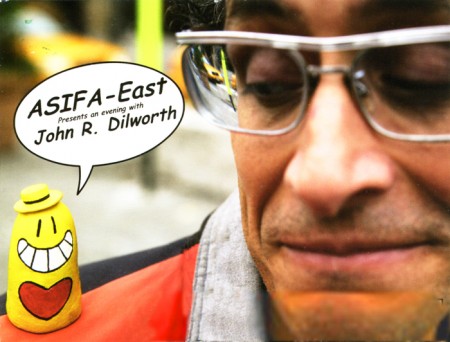
Tonight, ASIFA-East is presenting an evening with John R. Dilworth. This means that John will be there with a number of surprise guests from his past and present, including Howard Beckerman, who taught him; me, who hired him; and Courage the Cowardly Dog, who was drawn by him. Given John’s affinity for the unexpected, it’s doubtful that it’ll be the typical Q&A.
Some of his shorts will be shown as well as several of his films. I could tell you which ones they are, but that would spoil the surprise.
The festivities begin at 7pm at the School of Visual Arts, 209 East 23rd St, 3rd floor amphitheatre. The admission price is free and worth every bit of it.
Of course, if you insist on buying some things, ASIFA calanders will be sold as will John Dilworth goodies.
.
 - Once again, let me promote The Fantastic Mr. Fox, an animated feature that I just love. There was a good interview with director, Wes Anderson, on Charlie Rose 11/30/09. There’s no direct link from here, but you can see this clip by going to Charlie Rose ‘s website, then typing in Wes Anderson on the search box. You can see the whole interview (about 30 mins) there.
- Once again, let me promote The Fantastic Mr. Fox, an animated feature that I just love. There was a good interview with director, Wes Anderson, on Charlie Rose 11/30/09. There’s no direct link from here, but you can see this clip by going to Charlie Rose ‘s website, then typing in Wes Anderson on the search box. You can see the whole interview (about 30 mins) there..
- Now for something different. Just for the opportunity of showing off some beautiful blue-pencilled ruffs by Frank Thomas, loaned to me by John Canemaker, I’m going to post them here. They’re from Sleeping Beauty, of course.
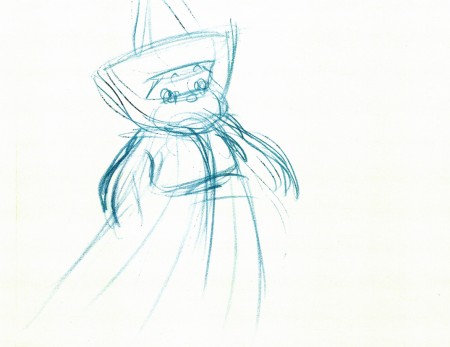 1
1
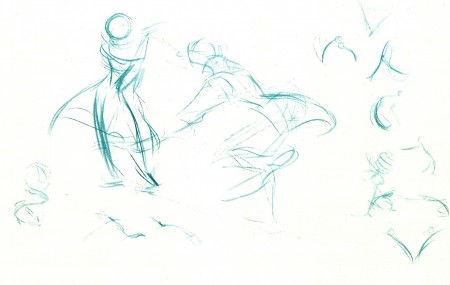 4
4
This last one is from Ichabod and Mr. Toad –
The Legend of Sleepy Hollow. Ichabod and Katrina.
_______________
- The most peculiar news story of the week was the headline at the top of Sunday’s NYTimes. It talked about a Taiwanese company that was creating their own videos of the news using cgi animation. The Times reports that the “. . . Taiwanese newspaper, Apple Daily, has dozens of programmers, designers, animators, even actors on its staff . . . responsible for scripting the videos.” We were shown a poorly created video of Tiger Woods (they admit that it didn’t really look like him, but they were happy over the color of his skin and his hair.) Maybe Robert Zemeckis could help out.
The question is how long it’ll take for ALL newcasts to include animated stories because they’re too lazy to do the actual reporting. Get rid of newspapers and make up your own videos. Apparently, MSNBC’s Keith Olberman made some sly comments about it. When he needs to make up the stories, he uses his “finger puppet theater.” In Taiwan they use cgi.
The world’s gone berserk, but now there’s a whole new line of work for animators of the future.
Here’s the YouTube presentation of that newscast.
Commentary 06 Dec 2009 09:39 am
Frogs
 - I’m a bit cranky. Having just come from Disney’s The Princess and the Frog, I’m not sure how to comment on it fairly. There were moments when I just relished the hand-drawn animation done at such a high level. I treasured the levels of technical depth being executed on the screen. I enjoyed whole sequences of animation and overall design choices. However, the story has such deep problems. I don’t intend to drag the film down with negatives.
- I’m a bit cranky. Having just come from Disney’s The Princess and the Frog, I’m not sure how to comment on it fairly. There were moments when I just relished the hand-drawn animation done at such a high level. I treasured the levels of technical depth being executed on the screen. I enjoyed whole sequences of animation and overall design choices. However, the story has such deep problems. I don’t intend to drag the film down with negatives.
I hope the film does well. 2D animation needs a boost. Would that someone had pulled the film in a straight-arrow direction and told the story more directly. But that isn’t the case.
I won’t complain about the incessant violence and loud actions in the film, but I will tell you something else that’s irritating the hell out of me. PR people have released information that I’ve seen repeated a few times. Anika Noni Rose repeated it on Jimmy Kimmel Friday night. They’re saying that she’s the first princess ever to sing and act the part, herself. Prior to her it was done by two people.
I suppose Adriana Caselotti as Snow White’s singing and acting voice doesn’t count. Nor does Ilene Woods as Cinderella, or Mary Costa as Sleeping Beauty, or Paige O’Hara as Belle. Can’t they even get their facts right about their own movies! Do they have to take away from the brilliant talent of some of the past films?
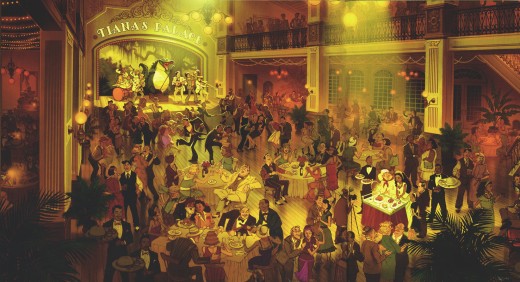
The two illustrations above come from Jeff Kurtti’s book, The Art of The Princess and the Frog. The pencil drawing was by Ruben Aquino, and the color sketch is by James Aaron Finch and Armand Baltazar.
Commentary &T.Hachtman 28 Nov 2009 08:51 am
Fox/List/Gert
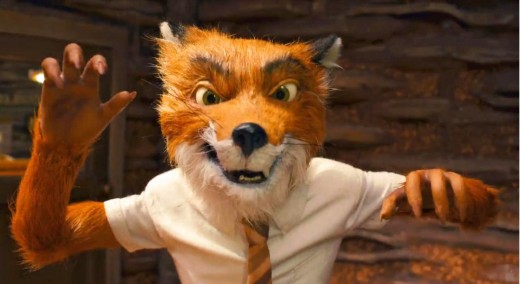
The Fantastic Mr. Fox – Did I tell you often enough that I really like this movie? One director – one voice. Independent spirit. Relatively low budget – $40 million. See it for fun.
- There’s a solid interview with Wes Anderson on the always enjoyable Onion’s AV CLub. His comments are worth reading, expecially if you’ve seen the film.
- Rotten Tomatoes, on the arrival of Disney’s The Princess and the Frog, has created a listing of Disney animated features and organized them into a list of titles. The order of the list is determined by some shaky criteria. Per Rotten Tomatoes: We used a weighted formula that takes into account the Tomatometer, number of reviews, and release year of every film included. We excluded all Disney subsidiaries and companies through which Disney has distribution deals hence, no films from Pixar, Studio Ghibli, or DisneyToon Studios are on the list.
Here’s their listing. Each title is followed by the Tomatometer rating:
- 1. Pinocchio 100%
2. Snow White 98%
3. Fantasia (1940) 98%
4. 101 Dalmatians 97%
5. Dumbo 97%
6. Beauty & the Beast 93%
7. Lion King 92%
8. Aladdin 92%
9. Cinderella 92%
10. Sleeping Beauty 91%
11. The Little Mermaid 90%
12. Bambi 89%
13. The Jungle Book 89%
14. Bolt 88%
15. Tarzan 88%
16. Lady and the Tramp 87%
17. Mulan 86%
18. Emperor’s New Groove 85%
19. Lilo and Stitch 85%
20. The Rescuers 84%
21. Fantasia 2000 82%
22. Hercules 83%
23. Peter Pan 83%
24. Alice In Wonderland 81%
25. The Hunchback of Notre Dame 72%
26. The Sword in the Stone 73%
27. Treasure Planet 70%
28. Meet the Robinsons 66%
29. Dinosaur 65%
30. The Aristocats 65%
31. The 3 Caballeros 87%
32. The Fox and the Hound 71%
33. Pocahontas 56%
34. Home on the Range 55%
35. Robin Hood. 55%
36. The Black Cauldron 58%
37. Atlantis: the Lost Continent 46%
38. Oliver and Company 44%
39. The Adventures of Ichabod & Mr. Toad 89%
40. The Rescuers Down Under 60%
41. The Many Adventures of Winnie the Pooh 91%
42. The Great Mouse Detective 79%
43. Brother Bear 38%
44. Chciken Little 36%
45. Saludos Amigos 70%
46. Melody Time 88%
47. Make Mine Music 67%
48. Fun and Fancy Free 67%
Just to amuse myself, I sought out all the Don Bluth films and compared their Tomatometer ratings to see which would be hightest. No surprises, except maybe that American Tale was rated so low. These aren’t graded the same way the Disney films were, above. Some of Bluth’s films weren’t rated:
- The Secret of NIMH 94%
Anastasia 85%
An American Tale 63%
Titan AE 51%
All Dogs Go to Heaven 44%
The Pebble and the Penguin 36%
Thumbelina 25%
Rock-A-Doodle 20%
Continuing the process let’s look at Ralph Bakshi‘s films. He didn’t fare as well as Bluth; some of Bakshi’s films weren’t reviewed either:
- Heavy Traffic 88%
American Pop 56%
Fritz the Cat 53%
Wizards 53%
The Lord of the Rings 47%
Cool World 6%
- After posting Tom Hachtman’s Renaissance Masters the past four weeks, I’m sort of out of sorts to not have any more of it. Let me post a couple of Gertrude & Alice cartoons to fill the void:
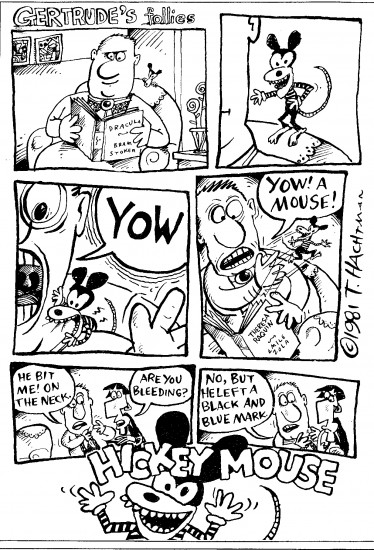
This one could be a comment on the “Twilight” experience.
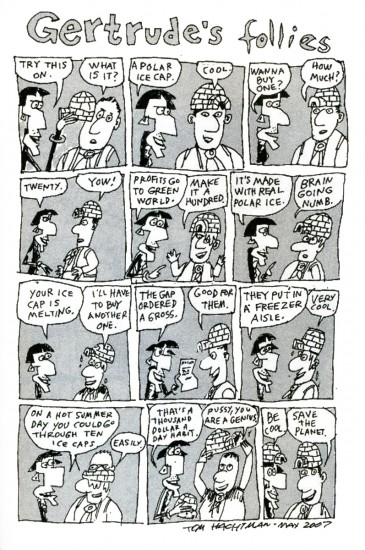
This week I heard about the after-show auction going on
at A Steady Rain‘s Broadway performances. Hugh Jackman &
Daniel Craig are raising cash for Broadway Cares by having
after-show auctions of their “sweaty” T-shirts.
Gert & Alice can do it for the environment.
And while I’m at it, let me post one of my favorite strips (which I’d posted once before.)
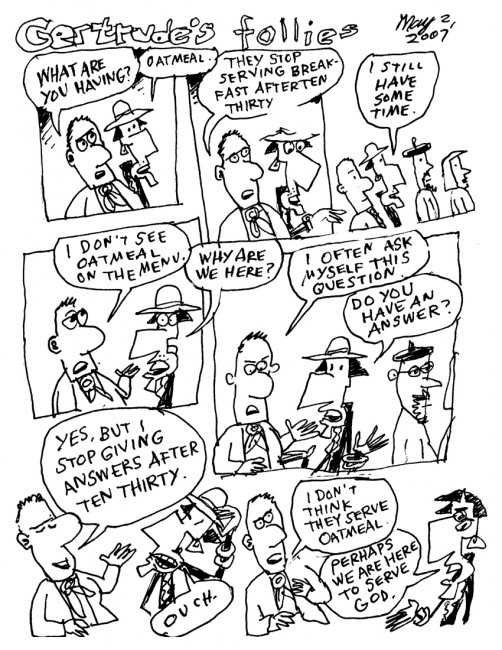
(Click any image to enlarge.)
Articles on Animation 24 Nov 2009 08:46 am
Alexeieff & Parker
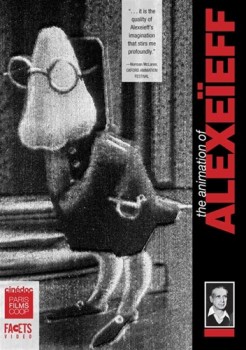 Svetlana Rockwell, the daughter of Alexandre Alexeieff has recently sent out a letter to several people worldwide. I was fortunate to have received a copy of this via Karl Cohen, the ASIFA-SF president.
Svetlana Rockwell, the daughter of Alexandre Alexeieff has recently sent out a letter to several people worldwide. I was fortunate to have received a copy of this via Karl Cohen, the ASIFA-SF president.
- I am very pleased to be able to let you know that my father Alexandre Alexeieff’s DVD has been produced in this country by FACETS in Chicago.
The DVD was originally put together by my agent Dominique Willoughby ,CINEDOC in Paris. It took him two years to do it.
The result is excellent. It was a work of love!
Years ago, when I read and re-read the Halas/Mavell book Technique of Film Animation, I was particularly curious to see films by Alexeieff & Parker. They were hardly available – even in New York. The best I could do was to see the titles to the Orson Welles’ film The Trial. I had to wait years to see others. These days, of course, like everything else they can be seen relatively easily thanks to such DVDs.
The disc includes their most important films including the renowned adaptation of Moussorgsky’s tone poem, Night on Bald Mountain. Over 30 films are featured, including short animations, stop-motion animated advertisements made for French cinemas, and photographs of Alexeieff’s still artwork.
It also includes The Pinscreen, a documentary by Norman McLaren; Mindscape, a film by Jacques Droulin; Alexeieff and Parker Making Three Moods, a documentary; and a gallery of photos and prints.
You can order the DVD directly from Facets in Chicago.
To give more information about the noted duo, whose work is probably not as well known today as it was even 10 years ago, I post this article by Alexeieff written for Animafilm #3, Jan. 1980:
as a profession
by Alexandre Alexeieff
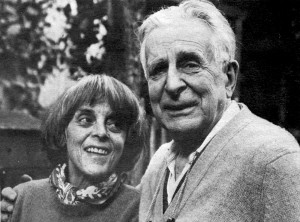 Does a country exist which would not seem to believe that it must possess a Museum, a School of Fine Arts teaching painting, sculpture, engraving and architecture, a Music Conservatory and an Opera House?
Does a country exist which would not seem to believe that it must possess a Museum, a School of Fine Arts teaching painting, sculpture, engraving and architecture, a Music Conservatory and an Opera House?
As if there were at any time and in every country great painters, sculptors and musicians… and yet History testifies that the reality is quite different: there are many countries which have never had any great painters, or else have had some, but for a limited time. ________________Claire Parker & Alexandre Alexeieff
For instance a country may have had a great poet hut never a great composer, and so on. A closer study of the history of culture shows that a period during which a given country enjoyed the flowering of one or several particular arts is hut of limited duration. Such a period is invariably followed by a gradual decline consisting of dreary routine due to an excessive respect for stereotyped rules imposed by the elders.
I am particularly impressed by the singular case of Russian classical literature, limited to the first decades of the 1 8th century. It so happened that before 1806 literate Russians spoke and wrote in French. The patriotic feeling engendered by the Napoleonic aggressions resulted in the new fashion of speaking and writing in the native tongue which, until then, had been used mainly by illiterate peasants. A handful of writers (among whom only Pushkin’s name is familiar to the West) ‘ lacking any national tradition, had to create the very language itself, in which they were’to write. Rut never since has Russian literature attained such grandeur. One is tempted to remember the famous line of the French playwright Racine: “.. .qui d’un coup d’essai font un coup de maltre…” What seemed to Racine an exception – an apprentice succeeding as if he were a master – is it an exception or, perhaps, a general rule?
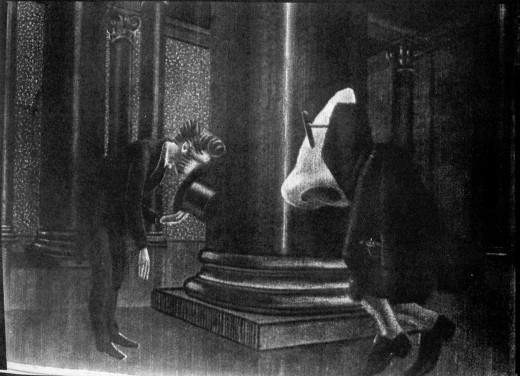
THE NOSE – (1963)
If I remember rightly, it happened around 1922, after the summer vacation was over, that the Cafe du Dome on Montparnasse, which by that time had supplanted the “Rotonde” as the meeting place of painters, opened its redecorated rooms. Its walls were ornate with new polychrome bas-reliefs of a most abominable design prevailing at that time on French banknotes. This discovery gave me immediately the strange certitude that French easel painting was dead for good. And indeed it so happened that after that year paintings of a frankly decorative character supplanted easel painting in everything but name.
I listened nevertheless to the teachings of the new masters with reverence. According to them the utmost care had to be bestowed upon COMPOSITION. Yet one had to care also about TEXTURE. Subsequently it was the preoccupation with texture, which I practised in my engravings, that resulted in the invention of the pinscreen (which is to my mind the purest example of what an engraved plate tends to be).
The year after that sad opening of the Cafe du Dome, when the pinscreen built by Claire and me empowered us to animate my engravings, I conceived that the forthcoming film of “animated engravings” was to show for the first time an image which would remain constantly composed in spite of its movement.
The very first screening of our first rush demonstrated that COMPOSITION was an affair of monumental painting and had nothing to do with movies.
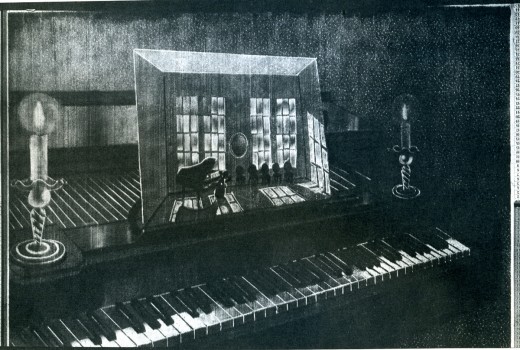
PICTURES AT AN EXHIBITION – (1972)
Forty-five years have elapsed. It no longer looks scandalous to read that easel painting exists no more. In private houses the SINGLE MOVING IMAGE tends to replace static paintings. The rich no longer buy bronze or marble, or paintings in their frozen frames: they buy instead trips to the inhabited inslands of the South Seas. As if humanity were discovering movement and time. As if the ephemeral, the transitory were taking the place of the eternal, the solid, the permanent. One no longer cares about the Seven , Wonders, one bids farewell to Antiquity.
Leaving the three-dimensional, humanity is entering into the fourth dimension.
One may suppose that animation’s destiny is to take the place of painting. Whether decorative or easel painting, does not matter – painting being lost in a maze of sterile scholastic speculations.
Is animation going to live side by side with that sort of animated photography which people call the cinema? Probably – yes, and yet the cinema will have to make some room for animation.
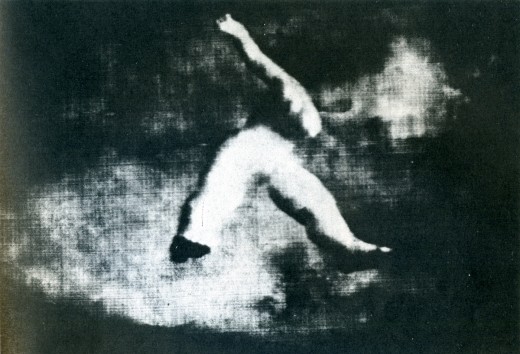
NIGHT ON BALD MOUNTAIN- (1933)
It was in the early 1930s that I saw Renoir’s film showing a white horse galloping on a background of dishevelled clouds. Apparently it was a double print: there were two shots, one of a horse and one of clouds. One of the prints was printed over the other… but I wondered what Renoir’s role was in all that. Dtdn’t he have to accept both horse and clouds such as they were? Certainly it was Re’noir who decided to print the two shots one over the other… was this all he did? Was his part of creation no more than combining recorded real events?
After 45 years, as I understand it motion picture animation is an acceleration of images and events entirely created by the imagination of the artist. These he has to slow down during the step-by-step process of creating the film.
When it crossed my mind to count the days, weeks and months which Claire and me had to spend under the lens of our camera in order to cumulate that time into no more than eight and a half minutes of film, I realised that this was a ratio of about 30,000 to one; reciprocally it might be said that we slowed down an 8 minute long action to some 540 days. There were days when I lived only a fraction of a second during the whole 6 hours of work. This required a discipline yet unknown to me in spite of the pretty hard training I was familiar with as an engraver. The thing looks to me like a sort of slow motion, but now not applied to film hut to human life itself: my life. This had to he so drastically slowed down in order to endow with life an image conceived and made hy me – an image or images of things which (unlike Renoir’s horse) never existed anywhere except in my mind.
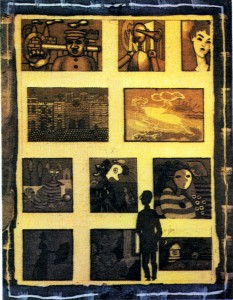 ACCELERATION? I had to examine that. From the start it occurred to me that ACCELERATION is the reverse of SLOW MOTION.
ACCELERATION? I had to examine that. From the start it occurred to me that ACCELERATION is the reverse of SLOW MOTION.
Who can remain indifferent hefore the grace of human and animal movements slowed down?
And yet, why does an acceleration (even a slight one, which is undergone by old films shot at 16 frames per second when screened at 24 f.p.sec.) -why does even so minimal an acceleration invariably look funny.
And more: are there other mechanical accelerations known among the arts? Yes, there are gramophone records of funeral marches which, if recorded at 33 revolutions per minute, sound like gay polkas when speeded up to 78 r.p.min. And in the reverse: a polka, recorded at 78 r.p.min, sounds grave and majestic if played at 33 r.p.min.
It is also illuminating to ponder over the instructions for the speed and character of the interpretation of musical scores: “moderato pesante” or “allargando” or “perdendosi” or “tranquillo”, if not “scherzando” or “andante grave”, even “con dolore” or “allegretto vivo” as well as “feroce” or “maestoso”.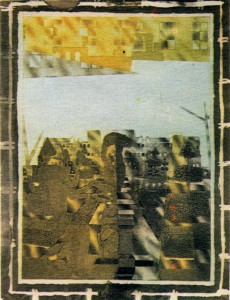
But how about “30,000 times faster”? This is much more than simply faster than “twice as fast”… Here the acceleration is so tremendously out of proportion -could quantity perhaps change the very quality? We cannot answer such a question, but we may note the general trend of animation to rush out of the control of the animator, who is invariably suprised on seeing his shot screened for the first time.
But let us admit also that it is monstrous to spend 18 months for 8 minutes of movement… And then there is that absence of slow motion, which animation ignores… that lack of gravity… that perpetual agitation… that compulsory burlesque… Is it possible that animation cannot do SOMETHING ELSE, as music can?
If I took the liberty to thus speak my mind, it is because I’ve been thinking along these lines for a very long time, I wonder whether some other people do not think like this as well. It is for them that I’m writing.
Doubtless I am not alone in wishing for an evolution. Others than me – Szczechura for instance – are revolutionizing animation admirably.
I also admit that serious subjects have never been well paid for, although burlesque brings in cash. But is big money so important? Impressionist painters did not make money during their lifetime.
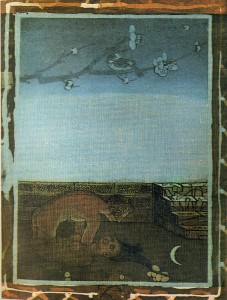 The history of the fine arts is like the card game named “patience”. A solitary game where the cards open their faces one after the other. The future will show what animation can do.
The history of the fine arts is like the card game named “patience”. A solitary game where the cards open their faces one after the other. The future will show what animation can do.
By the way – is there an animator who wouldn’t wish to speed up his production process? This implies the reduction of the ratio between production time and screening time (speeding up production spells out slowing down the acceleration). Therefore Claire and I are presently trying to reduce the speed of out animation to the tempo of slow motion, and I believe we can do it… at least sometimes. Last spring we succeeded in going 50-timcs slower. If we were shooting NIGHT ON BARE MOUNTAIN these days, we might reduce the ratio of 30,000 times to 600 which is almost tolerable.
English version corrected by Claire Parker
©1979, by Alexandre Alexeieff and “Animafilm”
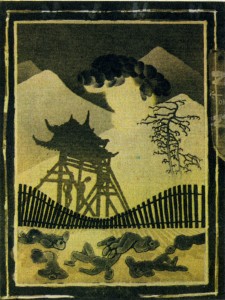 Claire Parker collaborated with Alexandre Alexe’ieff in the production of all his films made on pin screen. She took part in the animation of all his films, excluding three commercial films which he made in Berlin, and LA PLUME DE F1N1ST – CLAIR FAUCON, made in Rome. The film biography covers their joint work.
Claire Parker collaborated with Alexandre Alexe’ieff in the production of all his films made on pin screen. She took part in the animation of all his films, excluding three commercial films which he made in Berlin, and LA PLUME DE F1N1ST – CLAIR FAUCON, made in Rome. The film biography covers their joint work.
1931 – work on the first pin screen: 500,000 little rods sharpened at one end, with a diameter 0.9mm. Surface: I x 1.20m.
1933 – first film, UNE NUIT SUR LE MONT CHAUVE (The Night on Mount Bald). Extremely warm reception of audiences, but poor distribution; six weeks at Pantheon (Paris) and two weefcs at the Academy (London).
1934-LA BELLE AU BO1S DORMANT (The Sleeping Beauty), the first color puppet film starring puppets used for advertising “Nicolas” wines. Cooperation with Jean Aurenche and Francis Poulence. Alexe’ieff gives up puppets and script writing for professionals.
1935-1940 – commercial films (color) with object animation. Cooperation with top European composers. New effects included in ads films of up to three minutes. Friendship with Bartosch.
1937 – an attempt at making a smaller pin screen: 50×65 cm with a simplified structure – a failure.
1940 – A.A. and C.P. find refuge in the U.S.A. Friendships with Canadians, especially with N. McLaren.
1943 – second pin screen. Dimensions 1×1.70 m, 1,400,000 sharp-pointed rods. Diameter 0.45 mm. EN PASSANT (Incidentally) – a film commissioned by the National Film Board of Canada. Lack of interest in this film in the U.S.A. Walt Disney imitates “The Night on Mount Bald” and A.A.’s GRAND FEUX POUR ARTHUR MARTIN (Great Fire for Arthur Martin), but the Americans are somehow distrustful towards Continental artists.
1947-back to Europe; problems: shortages of paper and electricity.
1951-TOTALISATION(Totalization), fortheBel-gian producer Paul Delpire, originates. The film FUMEES (Smokes).
1956 – Films: SEVE DE LA TERRE (Earth Juices), MASQUERS (The Disguised), PURE BEAUTE (Pure Beauty). Admission to the Cineastes Associes.
1963-LE NEZ (The Nose).
1964 – last, 31st commercial advertising film, DE L’EAU (The Wafers,). The producer congratulates A.A. and C.P. on the film but fails to screen it.
1968 – new pin screen with a- more complicated construction. Dimensions: 45×55 cm., 250,000 sharp-ended rodlets. Diameter: 0.45 mm.
1972 – the film TABLEAUX D’UNE EXPOSITION (Pictures at an Exhibition), made on two pin screens. National Film Board of Canada purchases the new screen made by A.A. and C.P.
1975 – an exhibition at the Annecy Castle.
1977 – another pin screen completed. Dimensions: 50×60 cm.; 275,000 rodlets pointed at both ends. Diameter: 0.49 mm. A new film in store, TROIS THEMES (The Three Themes).
Color Images #5-#8: Graphics by Alexandre Alexeieff
Daily post 21 Nov 2009 02:38 am
Shorts Short List
The Renaissance Masters – 4 will conclude tomorrow, Sunday.
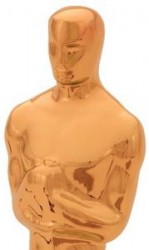 - There have been a number of newspaper articles about the released short list of Academy Award entrees for Best Documentary. Many of the more popular films – such as Michael Moore’s Capitalism: a love story and The September Issue – have been left off the list. This has caused some feedback for the Academy.
- There have been a number of newspaper articles about the released short list of Academy Award entrees for Best Documentary. Many of the more popular films – such as Michael Moore’s Capitalism: a love story and The September Issue – have been left off the list. This has caused some feedback for the Academy.
The short list of entrees for the Best Animated Feature film has also gotten a lot of attention in newpapers and on blogs. A record 20 films have been entered and are probably eligible – meaning there may be as many as 5 nominees this year.
The Academy has never previously released the short list of the nominees for the Best Animated Short.
Until today.
These are the ten films vying for the Oscar nomination for that award. They’re listed below in alphabetical order by title, with their director and production company:
The Cat Piano
Eddie White and Ari Gibson, directors (The People’s Republic of Animation)
French Roast
Fabrice O. Joubert, director (Pumpkin Factory/Bibo Films)
Granny O’Grimm’s Sleeping Beauty
Nicky Phelan, director, and Darragh O’Connell, producer (Brown Bag Films)
The Kinematograph
Tomek Baginski, director-producer (Platige Image)
The Lady and the Reaper (La Dama y la Muerte)
Javier Recio Gracia, director (Kandor Graphics and Green Moon)
Logorama
Nicolas Schmerkin, producer (Autour de Minuit)
A Matter of Loaf and Death
Nick Park, director (Aardman Animations Ltd.)
Partly Cloudy
Peter Sohn, director (Pixar Animation Studios)
Runaway
Cordell Barker, director (National Film Board of Canada)
Varieté
Roelof van den Bergh, director (il Luster Productions)
The following were all of the films that were eligible and competed for the short list. Congratulations to all for having produced films of such high calibre.
1. GETTING OVER HIM IN 8 SONGS OR LESS – 28mins – Debra Solomon
2. KANIZSA HILL – 8min – Evelyn Lee
3. ALICE’S ATTIC – 3mins – Robyn Yannoukos
4. HE’S BARACK OBAMA – 2mins – JibJab
5. SEBASTIAN’S VOODOO – 4mins – Joaquin Baldwin
6. THE KINEMATOGRAPH – 12ins – Tomek BagiÅ„ski
7. HORN DOG – 5mins – Bill Plympton
8. VARIETÉ – 5mins – Roelof van den Bergh
9. ALMA – 6mins – Rodrigo Blaas
10. BIRTH – 12mins – Signe Bauman
11. CAGES – 10mins – Juan Jose Medina
12. CHROMA CHAMELEON – 5mins – Marc F. Adler & Warren Grubb
13. ClKORJA AN’ KAFE (Chicory ‘n Coffee) – 8mins – Dusan Kastelic
14. ESTERHAZY – 23min – Izabela Plucinska
15. JACINTA Р9mins РKarla Casta̱eda
16. LA INCREJBLE HISTORIA DEL HOMBRE SIN SOMBRA Р9mins РJos̩ Esteban Alenda
17. LEONARDO -10mins – Jim Capobianco
18. LIVE MUSIC – 6mins – Hugh Hart
19. LOGORAMA – 17mins – H5, a French design collective,
20. A MATTER OF LOAF AN DEATH – 29mins – Nick Park
21. PARTLY CLOUDY – 6mins – Peter Sohn
22. PATIENCE OF THE MEMORY – 7mins – Vuk Jevremovic
23. PIGEON: IMPOSSIBLE – 6mins – Lucas Martell
24. RINKY DINK – 5mins – John Dilworth
26. RUNAWAY – 9mins – Cordell Barker
26. SLAVES – AN ANIMATED DOCUMENTARY – 15mins – David Aronowitsch & Hanna Heilborn
27. THE SPINE – 11mins – Chris Landreth
28. TABLE FELLOWSHIP – 2mins – Robert Colon
29. VALISE – 7mins – Isabelle Favez
30. VIVE LA ROSE -5mins – Bruce Alcock
31. WHEN APPLES ROLL -7mins – Reinis Kalnaellis
32, YOU’RE OUTA HERE – 3mins – George Griffin
33. THE BIRTHDAY GIFT – 8mins –
34. THE CAT PIANO – 8mins – Eddie White & Ari Gibson
35. FRENCH ROAST – 8mins – Fabrice O. Joubert
36. THE LADY AND THE REAPER (La Dama y La Muerte) – 8mins – Javier Recio
37. GRANNY O’GRIMM’S SLEEPING BEAUTY – 6 mins – Nicky Phelan
Short Films and Feature Animation Branch members will now select the five nominees from among the 10 titles on the shortlist. Branch screenings will be held in Los Angeles, New York and San Francisco in January 2010. The 82nd Academy Awards nominations will be announced on Tuesday, February 2, 2010, at 8:30 a.m. EST in the Academy’s Samuel Goldwyn Theater.
Thanks to Karl Cohen for the information.
Books &Commentary &walk cycle 12 Sep 2009 07:40 am
Cartooning
- When I was a kid, there were few resources one could turn to for information about animation and the process of making these films. Before computers, information was somewhat more difficult to acquire.
I couldn’t afford many books on the subject. Of course, I owned the Preston Blair book and that other Walter T. Foster book about Making Animated Cartoons (the one that wasn’t drawn very well and included animation examples that just didn’t work.) My treasure was the 1958 Bob Thomas book, The Art of Animation, with its technicolor focus on Sleeping Beauty.
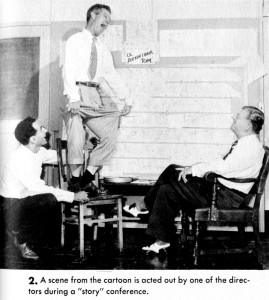 I also clipped every magazine/newspaper article or image I could find about cartoons and saved it in a homemade scrapbook. It would be years before I came upon Mike Barrier‘s Funnyworld Magazine or any other mag, for that matter, that focused exclusively on animation or cartooning.
I also clipped every magazine/newspaper article or image I could find about cartoons and saved it in a homemade scrapbook. It would be years before I came upon Mike Barrier‘s Funnyworld Magazine or any other mag, for that matter, that focused exclusively on animation or cartooning.
There were other books, and I went to the library to check them out monthly. I treasured that library copy of Robert Field‘s The Art of Walt Disney that I read over and over again. I appreciated Nat Falk‘s How to Make Animated Cartoons.
There was one book The Complete Guide to Cartooning by Gene Byrnes that had a chapter on MGM cartoons. This book had some of the greatest photos in it. Animators, inkers, directors, cels and sound effects. The pictures were great in that forties kinda way that just had me drooling animation when I looked at it. (It was published in Jan, 1950.)
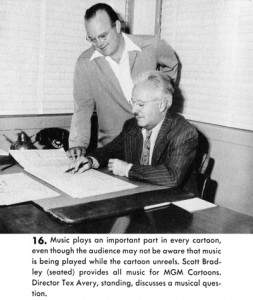 This came to me years ago when I found the animation section of this book on line. I haven’t been able to locate the site again; if I do, I’ll post the link or scan the section myself to post.
This came to me years ago when I found the animation section of this book on line. I haven’t been able to locate the site again; if I do, I’ll post the link or scan the section myself to post.
It came again recently when friend, Tom Hachtman, visited and brought a copy he owned to see if I knew about it. Of course, opening the whole book was like going home again after dozens of years. I knew every page intimately.
Two pages that stood out followed the MGM section and had the same effect within the book of seeing a Terrytoons cartoon after seeing one from MGM. Low rent. The pages look like left overs from Nat Falk’s book (and may, in fact, have been part of one of his books.)
However it amused me to look them over and actually run the peculiar walk cycle through AfterEffects to watch the motion. There are no registration marks, so I had to guess. (I didn’t take a lot of time with this, believe me.)
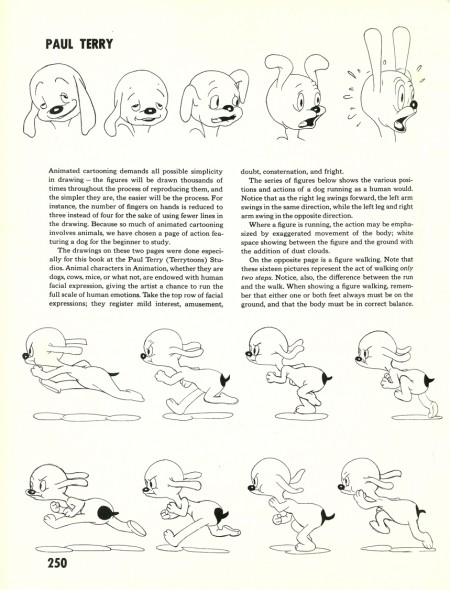
(Click any image to enlarge.)
.
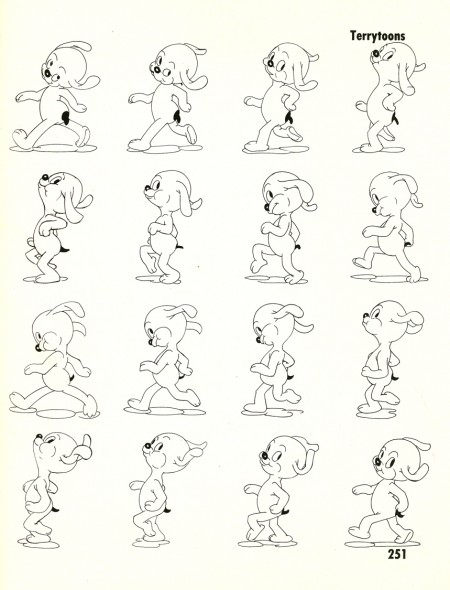
Here’s the QT of the odd pupwalk:
Pupwalk on two’s
I’m not sure who animated this – my guess Connie Rasinski
Click left side of the black bar to play.
Right side to watch single frame.
